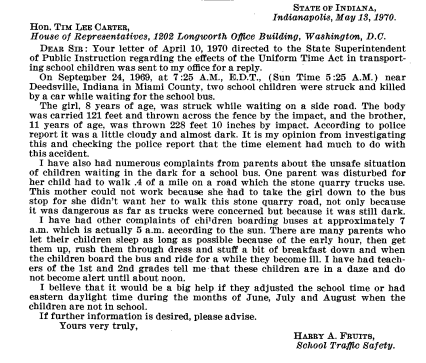So much of our lives is controlled by time. Whether it is 8 a.m. or 8 p.m. determines whether we are getting ready for work or getting ready for bed. However, nothing quite illustrates the fact that time is a made-up construct than the history of daylight saving—in fact, for two decades of the 20th century, states were even allowed to make up their own daylight saving rules, often rendering time zones meaningless.
With the Senate recently passing the Sunshine Protection Act,[1]168 Cong. Rec. D264 (2022). This document can be found in HeinOnline’s U.S. Congressional Documents database. which proposes year-round daylight saving time (DST), we thought it would be a great time (pun intended) to dive into the complex and often confusing history of humankind’s desire to preserve daylight. Follow along with us as we use relevant resources from the following HeinOnline databases:
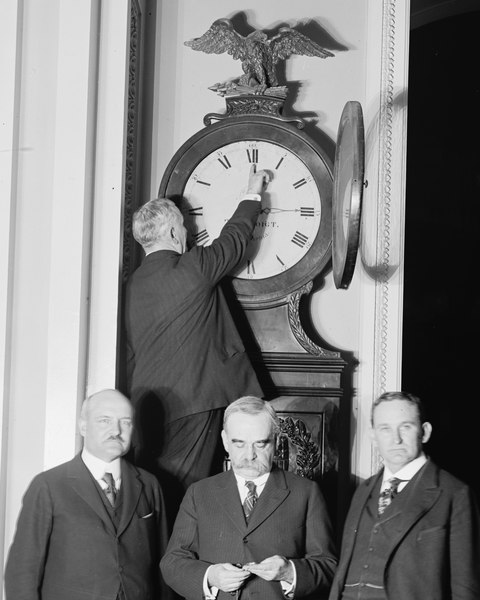
The Origins of the Daylight Saving Concept
The concept of daylight saving was first jokingly proposed by Benjamin Franklin in 1784, when he submitted a satirical article to The Journal of Paris titled, “An Economical Project for Diminishing the Cost of Light.”[2]Steve P. Calandrillo & Dustin E. Buehler, Time Well Spent: An Economic Analysis of Daylight Saving Time Legislation, 43 WAKE Forest L. REV. 45 (2008). This article can be found in HeinOnline’s Law Journal Library. In the article, Franklin joked that French people should save on the cost of candles by waking up earlier to fully utilize the natural morning light when going about their daily tasks.
However, DST was first seriously proposed by a New Zealand entomologist named George Hudson, who proposed a two-hour time shift in the interest of having more daylight time to observe insects after his work shifts. A similar concept to move the clock forward during the summer was proposed by Englishman William Willett,[3]1 (December 17, 2002) Daylight Saving Time. This CRS report can be found in HeinOnline’s U.S. Congressional Documents database. and the proposal even made it to Parliament, where the first Daylight Saving Bill was presented in early 1908—however, it didn’t pass.
Countries Begin to Enact DST
The first city to implement daylight saving was Port Arthur in Ontario, Canada, on July 1, 1908. However, countries didn’t begin to enact their own DST policies until World War I. Germany, in an effort to conserve fuel for their troops, moved the clocks forward on May 1, 1916, and many other European countries soon followed suit.[4]Marcus M. Marks, Daylight Saving, 6 NAT’l MUN. REV. 465 (1917). This article can be found in HeinOnline’s Law Journal Library.
In the United States, Congress passed the Standard Time Act of March 19, 1918,[5]To save daylight and to provide standard time for the United States., Public Law 65-106 / Chapter 24, 65 Congress. 40 Stat. 450 (1918). This act can be found in HeinOnline’s U.S. Statutes at Large database. which solidified the country’s time zones and established daylight saving to begin on March 31 and end on October 27. However, this new policy was not popular with many, including farmers,[6]“Repeal of daylight saving law, with minority. report.” U.S. Congressional Serial Set, , 1919, pp. 1-32. HeinOnline, https://heinonline.org/HOL/P?h=hein.usccsset/usconset24743&i=126. This document can be found in … Continue reading who needed morning daylight in order to milk their cows and harvest crops. DST was not long-lasting at this point, though—it was eliminated after the war and left to local jurisdictions to determine whether they would continue with it. Many metropolitan areas, like New York City and Boston, continued to use daylight saving, while surrounding rural areas did not.
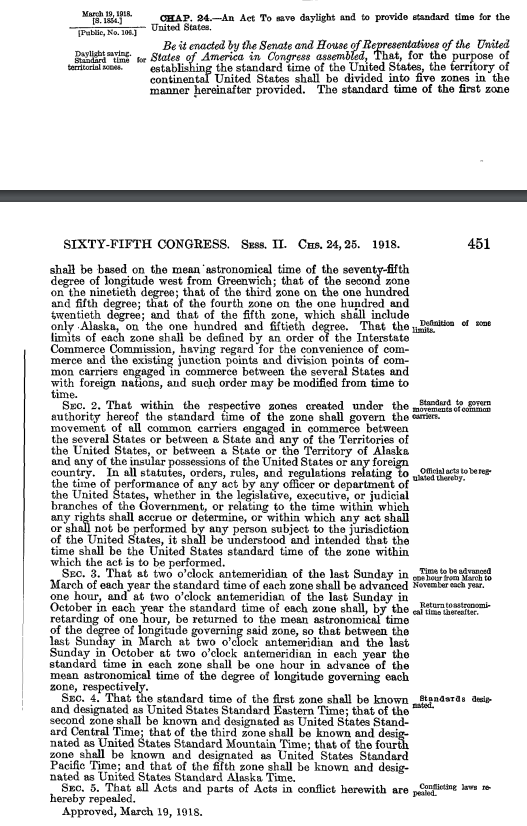
War Time
With World War II came the institution of DST yet again in the United States. Called “War Time,” then-president Franklin D. Roosevelt enacted year-round daylight saving, to begin on February 9, 1942, and last until September 30, 1945, with mixed opinions from Americans.[7]90 Cong. Rec. A1477 (1944). This document can be found in HeinOnline’s U.S. Congressional Documents database. Even after this period ended, some areas continued to use DST, especially in the Northeast. However, for the next two decades, there was no consistency to daylight saving. States and cities could adopt their own DST policies, which, understandably, led to much confusion and particularly hindered the transportation industry.[8]87 Cong. Rec. A1185 (1941). This document can be found in HeinOnline’s U.S. Congressional Documents database.
As a result, Congress passed the Uniform Time Act of 1966,[9]To promote the observance of a uniform system of time throughout the United States., Public Law 89-387, 89 Congress. 80 Stat. 107 (1966). This act can be found in HeinOnline’s U.S. Statutes at Large database. implementing a consistent daylight saving time across the U.S.—clocks were to be pushed one hour ahead at 2 a.m. on the last Sunday of April, and then turned back an hour on the last Sunday of October.

State Exemptions and Continued DST Changes
Arizona and Michigan exempted themselves from the Uniform Time Act[10]“Uniform time act amendment.” , , 1972, pp. 1-10. HeinOnline, https://heinonline.org/HOL/P?h=hein.usccsset/usconset21430&i=1097. This document can be found in HeinOnline’s U.S. Congressional Serial Set. in 1967 (although Michigan would start observing DST again just a few years later in 1972). In 1973, the Organization of Arab Petroleum Exporting Countries (OAPEC) oil embargo caused fuel shortages that inspired Congress to enact a trial period of year-round daylight saving,[11]To provide for daylight saving time on a year-round basis for a two-year trial period, and to require the Federal Communications Commission to permit certain daytime broadcast stations to operate before local sunrise., Public Law 93-182, 93 … Continue reading beginning on January 6, 1974, and ending on April 27, 1975.
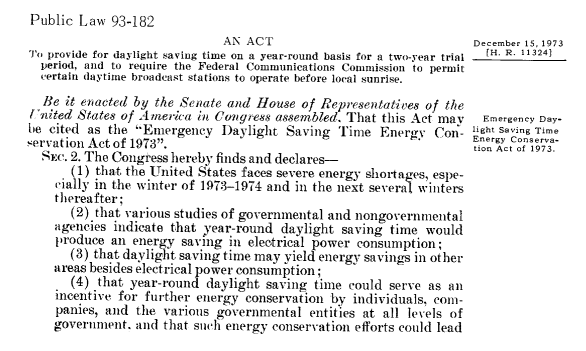
During that year, support for year-round DST dropped significantly as parents worried about their children leaving for school in the dark, while they themselves had to commute to work in the dark. Therefore, Congress amended the act in October 1974 to end DST[12]To amend the Emergency Daylight Saving Time Energy Conservation Act of 1973 to exempt from its provisions the period from the last Sunday in October, 1974, through the last Sunday in February, 1975., Public Law 93-434, 93 Congress. 88 Stat. 1209 … Continue reading and revert back to standard time until the regular summer daylight saving began again the next year.
In 1987, the Uniform Time Act was amended[13]To authorize appropriations for activities under the Federal Fire Prevention and Control Act of 1974., Public Law 99-359, 99 Congress. 100 Stat. 764 (1986). This act can be found in HeinOnline’s U.S. Statutes at Large database. to change the daylight saving period to the first Sunday in April until the last Sunday in October.
Today’s Daylight Saving
The Energy Policy Act of 2005[14]Energy Policy Act of 2005 , Public Law 109-58, 109 Congress. 119 Stat. 594 (2005). This act can be found in HeinOnline’s U.S. Statutes at Large database. extended daylight saving to the period that we are used to today—beginning in 2007, DST would begin the second Sunday of March and end on the first Sunday of November.[15]Energy Policy Act of 2005 , Public Law 109-58, 109 Congress. 119 Stat. 594 (2005). This act can be found in HeinOnline’s U.S. Statutes at Large database. Since then, several states have requested to switch to year-round DST, including Alabama, Arkansas, California, Delaware, Florida, Georgia, Idaho, Louisiana, Maine, Minnesota, Mississippi, Montana, Ohio, Oregon, South Carolina, Tennessee Utah, Washington, and Wyoming. However, currently, the Uniform Time Act only allows for states to eliminate DST; they aren’t allowed to enact permanent DST.
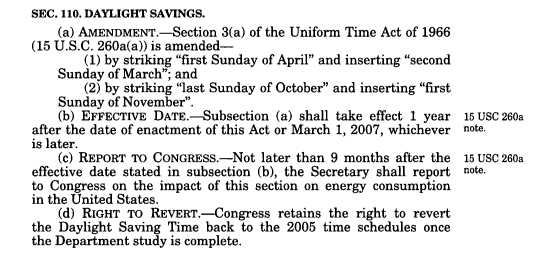
Today, Hawaii and most of Arizona, with the exception of the Navajo Nation, don’t observe daylight saving.[16]1 [ii] (2016) Daylight Saving Time. This CRS report can be found in HeinOnline’s U.S. Congressional Documents database. Additionally, American Samoa, Guam, the Northern Mariana Islands, Puerto Rico, and the Virgin Islands also use standard time year-round.
Senator Marco Rubio of Florida first proposed the Sunshine Protection Act of 2018,[17]1 14 (July 18, 2019) Daylight Saving Time. This CRS report can be found in HeinOnline’s U.S. Congressional Documents database. which would make daylight saving the standard time throughout the United States. This act was passed unanimously by the Senate on March 15.[18]168 Cong. Rec. S1157 (2022). This document can be found in HeinOnline’s U.S. Congressional Documents database. However, it still must pass in the House and be signed by President Biden in order to become law.
HeinOnline Is Always on Time
No matter if the clocks are sprung forward or fallen back, HeinOnline will continue to post on our blog, so make sure that you are subscribed so that you always receive the latest history, politics, content features, and more right to your inbox!
HeinOnline Sources[+]
| ↑1 | 168 Cong. Rec. D264 (2022). This document can be found in HeinOnline’s U.S. Congressional Documents database. |
|---|---|
| ↑2 | Steve P. Calandrillo & Dustin E. Buehler, Time Well Spent: An Economic Analysis of Daylight Saving Time Legislation, 43 WAKE Forest L. REV. 45 (2008). This article can be found in HeinOnline’s Law Journal Library. |
| ↑3 | 1 (December 17, 2002) Daylight Saving Time. This CRS report can be found in HeinOnline’s U.S. Congressional Documents database. |
| ↑4 | Marcus M. Marks, Daylight Saving, 6 NAT’l MUN. REV. 465 (1917). This article can be found in HeinOnline’s Law Journal Library. |
| ↑5 | To save daylight and to provide standard time for the United States., Public Law 65-106 / Chapter 24, 65 Congress. 40 Stat. 450 (1918). This act can be found in HeinOnline’s U.S. Statutes at Large database. |
| ↑6 | “Repeal of daylight saving law, with minority. report.” U.S. Congressional Serial Set, , 1919, pp. 1-32. HeinOnline, https://heinonline.org/HOL/P?h=hein.usccsset/usconset24743&i=126. This document can be found in HeinOnline’s U.S. Congressional Serial Set. |
| ↑7 | 90 Cong. Rec. A1477 (1944). This document can be found in HeinOnline’s U.S. Congressional Documents database. |
| ↑8 | 87 Cong. Rec. A1185 (1941). This document can be found in HeinOnline’s U.S. Congressional Documents database. |
| ↑9 | To promote the observance of a uniform system of time throughout the United States., Public Law 89-387, 89 Congress. 80 Stat. 107 (1966). This act can be found in HeinOnline’s U.S. Statutes at Large database. |
| ↑10 | “Uniform time act amendment.” , , 1972, pp. 1-10. HeinOnline, https://heinonline.org/HOL/P?h=hein.usccsset/usconset21430&i=1097. This document can be found in HeinOnline’s U.S. Congressional Serial Set. |
| ↑11 | To provide for daylight saving time on a year-round basis for a two-year trial period, and to require the Federal Communications Commission to permit certain daytime broadcast stations to operate before local sunrise., Public Law 93-182, 93 Congress. 87 Stat. 707 (1973). This act can be found in HeinOnline’s U.S. Statutes at Large database. |
| ↑12 | To amend the Emergency Daylight Saving Time Energy Conservation Act of 1973 to exempt from its provisions the period from the last Sunday in October, 1974, through the last Sunday in February, 1975., Public Law 93-434, 93 Congress. 88 Stat. 1209 (1974). This act can be found in HeinOnline’s U.S. Statutes at Large database. |
| ↑13 | To authorize appropriations for activities under the Federal Fire Prevention and Control Act of 1974., Public Law 99-359, 99 Congress. 100 Stat. 764 (1986). This act can be found in HeinOnline’s U.S. Statutes at Large database. |
| ↑14, ↑15 | Energy Policy Act of 2005 , Public Law 109-58, 109 Congress. 119 Stat. 594 (2005). This act can be found in HeinOnline’s U.S. Statutes at Large database. |
| ↑16 | 1 [ii] (2016) Daylight Saving Time. This CRS report can be found in HeinOnline’s U.S. Congressional Documents database. |
| ↑17 | 1 14 (July 18, 2019) Daylight Saving Time. This CRS report can be found in HeinOnline’s U.S. Congressional Documents database. |
| ↑18 | 168 Cong. Rec. S1157 (2022). This document can be found in HeinOnline’s U.S. Congressional Documents database. |

